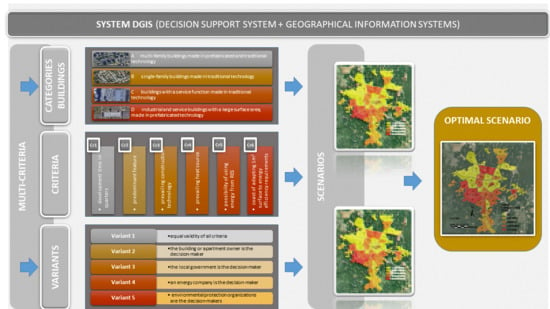An Innovative Decision Support System to Improve the Energy Efficiency of Buildings in Urban Areas
Abstract
1. Introduction
Background
2. Materials and Methods
2.1. Study Area
2.2. Methodology
- Step 1—defining the analysis goal. This is identifying the energy efficiency potential in urban areas, building energy scenarios depending on the decision-maker, and analyzing the acceptable solution set M:
- Step 2—defining of the initial set of criteria and analysis taking into account the representativeness of the criteria, interrelationships between the criteria, and the level of detail of the description of the subject of assessment; construction of the final set of criteria C with the number n:
- Step 3—setting the criteria weights with the participation of the decision-maker and experts: because the criteria have unequal validity, hierarchical factors (weights) should be entered in the analysis process:
- Step 4—determination of numerical measures of individual analysis variants:based on the determined criteria measures, a data Z matrix is obtained
- Step 5—assessment of variant solutions based on a synthetic assessment. The result is finding the most advantageous variant in terms of the adopted criteria—the ability to make appropriate decisions. To do this, the value of each variant should be calculated using one of the synthetic formulas, which in the case of research is the adjusted summation index, defined as:where: S—value of individual variants, z*—measure of each of the variants, and w—criterion weight, which is determined by the decision-maker individually or after obtaining an expert opinion.
- Phase 1—clarifying the purpose of the analysis—determining the energy potential in individual decision variants and defining the initial set of criteria, and, as a consequence, determining the final criteria set affecting energy consumption in buildings. At the same time, preparation of GIS layers using ArcGIS 10.7—vectorization of reference units and determination of the prevailing category of buildings.
- Phase 2—determining the weighting of criteria with the participation of decision-makers and experts, determining the numerical measures of individual variants subject to analysis, and coding partial measures of individual variants using standardization. Calculations were carried out using MATLABTM software. Because in this study the criteria and weightings of the criteria were developed based on the opinions of decision-makers and experts, preliminarily prepared reports were forwarded to experts for assessment, improvement, and possible supplementation. All experts had knowledge and experience in the research topic.
- Phase3—analysis of the results obtained using GIS tools, which allowed verification of the results achieved depending on the decision variant, expert opinions, and the predominant category of objects located in reference units.
3. Results and Discussion
- -
- Construction time in quarters (Cr1)— five periods picked out that represented buildings in the quarters: until 1965, 1966–1985, 1986–1992, 1993–2008, and from 2009. The time intervals were determined based on the dominant period of ongoing construction investments.
- -
- Overwhelming function (Cr2)—four overwhelming functions have been distinguished: residential, residential-service, service, and industrial.
- -
- Predominant manufacturing technology (Cr3)—two dominant ways of constructing objects (technology): traditional and prefabricated.
- -
- The predominant source of heat (Cr4)—three types of urban areas have been distinguished: with a predominance of buildings heated with a solid fuel boiler, with a predominance of buildings supplied with heat by CHP, with a predominance of buildings heated with cold gas boilers.
- -
- The possibility of using energy from renewable energy sources (Cr5)—three levels showing the willingness of decision-makers to invest in renewable energy sources and taking into account the technical possibilities of obtaining energy from renewable energy sources: low, medium, high.
- -
- Cost of bringing 1 m2 of the facility to EU requirements for energy efficiency (Cr6)—the cost has been estimated for individual categories of buildings (A, B, C, D) based on the data contained in the study [44].
3.1. Discussion
3.2. Summary of Research
4. Conclusions
Author Contributions
Funding
Conflicts of Interest
References
- Krellenberg, K.; Link, F.; Welz, J.; Harris, J.; Barth, K.; Irarrazaval, F. Supporting local adaptation: The contribution of socio-environmental fragmentation to urban vulnerability. Appl. Geogr. 2014, 55, 61–70. [Google Scholar] [CrossRef]
- Kazak, J.K.; Chruściński, J.; Szewrański, S. The development of a novel decision support system for the location of green infrastructure for stormwater management. Sustainability 2018, 10, 4388. [Google Scholar] [CrossRef]
- Nowogońska, B. Diagnoses in the Aging Process of Residential Buildings Constructed Using Traditional Technology. Buildings 2019, 9, 126. [Google Scholar] [CrossRef]
- Buffel, T.; Phillipson, C. Can Global Cities Be ‘Age-Friendly Cities’? Urban Development and Ageing Populations. Cities 2014, 55, 94–100. [Google Scholar] [CrossRef]
- European Environment Agency. Urban Adaptation to Climate Change in Europe 2016. Transforming Cities in a Changing Climate; Publications Office of the European Union: Luxembourg, 2016. [Google Scholar]
- Szopińska, E.; Kazak, J.; Kempa, O.; Rubaszek, J. Spatial form of greenery in strategic environmental management in the context of urban adaptation to climate change. Pol. J. Environ. Stud. 2019, 28, 2845–2856. [Google Scholar] [CrossRef]
- Berardi, U. A cross-country comparison of the building energy consumptions and their trends. Resour. Conserv. Recycl. 2017, 123, 230–241. [Google Scholar] [CrossRef]
- Szyszka, J.; Kogut, J.; Skrzypczak, I.; Kokoszka, W. Selective internal heat distribution in modified trombe wall. IOP Conf. Ser. Earth Environ. Sci. 2017, 95, 042018. [Google Scholar] [CrossRef]
- Staszczuk, A.; Kuczyński, T. The impact of floor thermal capacity on air temperature and energy consumption in buildings in temperate climate. Energy 2019, 181, 908–915. [Google Scholar] [CrossRef]
- AlAjmi, A.; Abou-Ziyan, H.; Ghoneim, A. Achieving annual and monthly net-zero energy of existing building in hot climate. Appl. Energy 2016, 165, 511–521. [Google Scholar] [CrossRef]
- Martinopoulos, G. Life Cycle Assessment of solar energy conversion systems in energetic retrofitted buildings. J. Build. Eng. 2018, 20, 256–263. [Google Scholar] [CrossRef]
- Baljit, S.S.S.; Chan, H.Y.; Sopian, K. Review of building integrated applications of photovoltaic and solar thermal systems. J. Clean. Prod. 2016, 137, 677–689. [Google Scholar] [CrossRef]
- Allouhi, A.; Zamzoum, O.; Islam, M.R.; Saidur, R.; Kousksou, T.; Jamil, A.; Derouich, A. Evaluation of wind energy potential in Morocco’s coastal regions. Renew. Sustain. Energy Rev. 2017, 72, 311–324. [Google Scholar] [CrossRef]
- Rezaeiha, A.; Kalkman, I.; Blocken, B. Effect of pitch angle on power performance and aerodynamics of a vertical axis wind turbine. Appl. Energy 2017, 197, 132–150. [Google Scholar] [CrossRef]
- Scarpa, F.; Tagliafico, L.A. Exploitation of humid air latent heat by means of solar assisted heat pumps operating below the dew point. Appl. Therm. Eng. 2016, 100, 820–828. [Google Scholar] [CrossRef]
- Bagheri, M.; Delbari, S.H.; Pakzadmanesh, M.; Kennedy, C.A. City-integrated renewable energy design for low-carbon and climate-resilient communities. Appl. Energy 2019, 239, 1212–1225. [Google Scholar] [CrossRef]
- Piwowar, A.; Dzikuć, M. Development of Renewable Energy Sources in the Context of Threats Resulting from Low-Altitude Emissions in Rural Areas in Poland: A Review. Energies 2019, 12, 3558. [Google Scholar] [CrossRef]
- Azaza, M.; Eskilsson, A.; Wallin, F. An open-source visualization platform for energy flows mapping and enhanced decision making. Energy Proced. 2019, 158, 3208–3214. [Google Scholar] [CrossRef]
- Mrówczyńska, M.; Łączak, A.; Bazan-Krzywoszańska, A.; Skiba, M. Improving energy efficiency with the risk of investment of reference to urban development of Zielona Góra. Teh. Vjesn. 2018, 25, 916–922. [Google Scholar]
- Hu, M. Building impact assessment—A combined life cycle assessment and multi-criteria decision analysis framework. Resour. Conserv. Recycl. 2019, 150, 104410. [Google Scholar] [CrossRef]
- Launay, S.; Kadoch, B.; Le Métayer, O.; Parrado, C. Analysis strategy for multi-criteria optimization: Application to inter-seasonal solar heat storage for residential building needs. Energy 2019, 171, 419–434. [Google Scholar] [CrossRef]
- Kozik, R.; Leśniak, A.; Majka, M. Application of multi-criteria analysis method for thermal insulation solutions selection. AIP Conf. Proc. 2019, 2116, 180010. [Google Scholar]
- Ziembicki, P.; Klimczak, M.; Bernasiński, J. Optimization of municipal energy systems with the use of an intelligent analytical system. Civ. Environ. Eng. Rep. 2018, 3, 132–144. [Google Scholar] [CrossRef]
- Ouria, M. Solar energy potential according to climatic and geometrical parameters of cities and buildings: A case-study from Tabriz City- Iran. Urban. Clim. 2019, 28, 100469. [Google Scholar] [CrossRef]
- Feyzi, S.; Khanmohammadi, M.; Abedinzadeh, N.; Aalipour, M. Multi- criteria decision analysis FANP based on GIS for siting municipal solid waste incineration power plant in the north of Iran. Sustain. Cities Soc. 2019, 47, 101513. [Google Scholar] [CrossRef]
- Arabameri, A.; Pradhan, B.; Rezaei, K.; Conoscenti, C. Gully erosion susceptibility mapping using GIS-based multi-criteria decision analysis techniques. Catena 2019, 180, 282–297. [Google Scholar] [CrossRef]
- Erbaş, M.; Kabak, M.; Özceylan, E.; Çetinkaya, C. Optimal siting of electric vehicle charging stations: A GIS-based fuzzy Multi-Criteria Decision Analysis. Energy 2018, 163, 1017–1031. [Google Scholar] [CrossRef]
- Díaz-Cuevas, P. GIS-Based Methodology for Evaluating the Wind-Energy Potential of Territories: A Case Study from Andalusia (Spain). Energies 2018, 11, 2789. [Google Scholar] [CrossRef]
- Özceylan, E.; Erbaş, M.; Tolon, M.; Kabak, M.; Durğut, T. Evaluation of freight villages: A GIS-based multi-criteria decision analysis. Comput. Ind. 2016, 76, 38–52. [Google Scholar] [CrossRef]
- Ghajari, Y.E.; Alesheikh, A.A.; Modiri, M.; Hosnavi, R.; Abbasi, M. Spatial Modelling of Urban Physical Vulnerability to Explosion Hazards Using GIS and Fuzzy MCDA. Sustainability 2017, 9, 1274. [Google Scholar] [CrossRef]
- Statistics Poland. Demographic Yearbook of Poland; Statistics Poland: Warsaw, Poland, 2019.
- Kaya, I.; Çolak, M.; Terzi, F. A comprehensive review of fuzzy multi criteria decision making methodologies for energy policy making. Energy Strategy Rev. 2019, 24, 207–228. [Google Scholar] [CrossRef]
- Zhou, Y.; Xu, L.; Shaikh, G.M. Evaluating and Prioritizing the Green Supply Chain Management Practices in Pakistan: Based on Delphi and Fuzzy AHP Approach. Symmetry 2019, 11, 1346. [Google Scholar] [CrossRef]
- Szafranko, E. Possibilities of application of multi-criteria analysis methods to evaluate material and technological solutions in the design of building structures. Mater. Today Proc. 2019, in press. [Google Scholar] [CrossRef]
- Jęglet, K. Wielokryterialna analiza systemów zaopatrzenia budynku w ciepło—Zagadnienie normalizacji kryteriów. Mater. Bud. 2018, 1, 6–9. [Google Scholar] [CrossRef]
- Żabicki, P.; Gardziejczyk, W. Issues of criteria normalization in the multicriteria analyzes in the design of roads. Bud. I Archit. 2014, 13, 325–333. [Google Scholar]
- Horta, A.; Gouveia, J.; Schmidt, L.; Sousa, J.; Palma, P.; Simões, S. Energy poverty in Portugal: Combining vulnerability mapping with household interviews. Energy Build. 2019, 203, 109423. [Google Scholar] [CrossRef]
- Bujarkiewicz, A.; Sztubecka, M.; Sztubecki, J. The study of using GIS tools in sustainable management of solar energy. Civ. Environ. Eng. Rep. 2018, 1, 26–39. [Google Scholar] [CrossRef]
- Tomlinson, R. Thinking about GIS: Geographic Information System Planning for Managers; ESRI Press: Redlands, CA, USA, 2003. [Google Scholar]
- Gotlib, D.; Wyszomirski, M. Cartographical presentation of BIM models. In Proceedings of the Baltic Geodetic Congress, BGC-Geomatics, Olsztyn, Poland, 21–23 June 2018; pp. 121–126. [Google Scholar]
- Rubinowicz, P. Visualisation of DSM as 3D-mesh for urban analyses. Adv. Intell. Syst. Comput. 2019, 809, 1013–1022. [Google Scholar]
- Malczewski, J. GIS-based multicriteria decision analysis: A survey of the literature. Int. J. Geogr. Inf. Sci. 2006, 20, 703–726. [Google Scholar] [CrossRef]
- Rozporządzenie Rady Ministrów z dnia 5 października 2012 roku w sprawie państwowego systemu odniesień przestrzennych. Available online: http://prawo.sejm.gov.pl/isap.nsf/download.xsp/WDU20120001247/O/D20121247.pdf (accessed on 27 December 2019).
- Town Energy Audit (TEA) of Zielona Góra. Research task No. 1: Analysis of possibilities and social and economic effects of improving energy effectiveness in buildings. In Strategic Programmes: Integrated System for Reducing Energy Consumption in the Maintenance of Buildings; Financed from the National Centre for Research and Development (NCBR) Contract No. SP/B/1/91454/10, NCBiR 2010; TEA: Zielona Góra, Poland, 2011; unpublished. [Google Scholar]
- SOZG. Statistical Yearbook—Lubuskie Voivodship 2017; Statistical Office in Zielona Gora: Zielona Gora, Poland, 2017. [Google Scholar]
- Neves, A.; Leal, V.; Lourenço, J. A methodology for sustainable and inclusive local energy planning. Sustain. Cities Soc. 2015, 17, 110–121. [Google Scholar] [CrossRef]
- Stanganelli, M.; Torrieri, F.; Gerundo, C.; Rossitti, M. An integrated strategic-performative planning methodology towards enhancing the sustainable decisional regeneration of fragile territories. Sustain. Cities Soc. 2020, 53, 101920. [Google Scholar] [CrossRef]
- Whitmarsh, L.; Corner, A. Tools for a new climate conversation: A mixed-methods study of language for public engagement across the political spectrum. Glob. Environ. Chang. 2017, 42, 122–135. [Google Scholar] [CrossRef]
- Fandi, G.; Krepl, V.; Ahmad, I.; Igbinovia, F.O.; Ivanova, T.; Fandie, S.; Muller, Z.; Tlusty, J. Design of an emergency energy system for a city assisted by renewable energy, case study: Latakia, Syria. Energies 2018, 11, 3138. [Google Scholar] [CrossRef]
- Abdulkarim, B.; Kamberov, R.; Hay, G.J. Supporting Urban Energy Efficiency with Volunteered Roof Information and the Google Maps API. Remote Sens. 2014, 6, 9691–9711. [Google Scholar] [CrossRef]
- Kim, A.A.; Sunitiyoso, Y.; Medal, L.A. Understanding facility management decision making for energy efficiency efforts for buildings at a higher education institution. Energy Build. 2019, 199, 197–215. [Google Scholar] [CrossRef]
- Hay, G.J.; Kyle, C.H.; Hemachandran, B.; Chen, G.; Rahman, M.M.; Fung, T.; Arvai, J.L. Geospatial Technologies to Improve Urban Energy Efficiency. Remote Sens. 2011, 3, 1380–1405. [Google Scholar] [CrossRef]
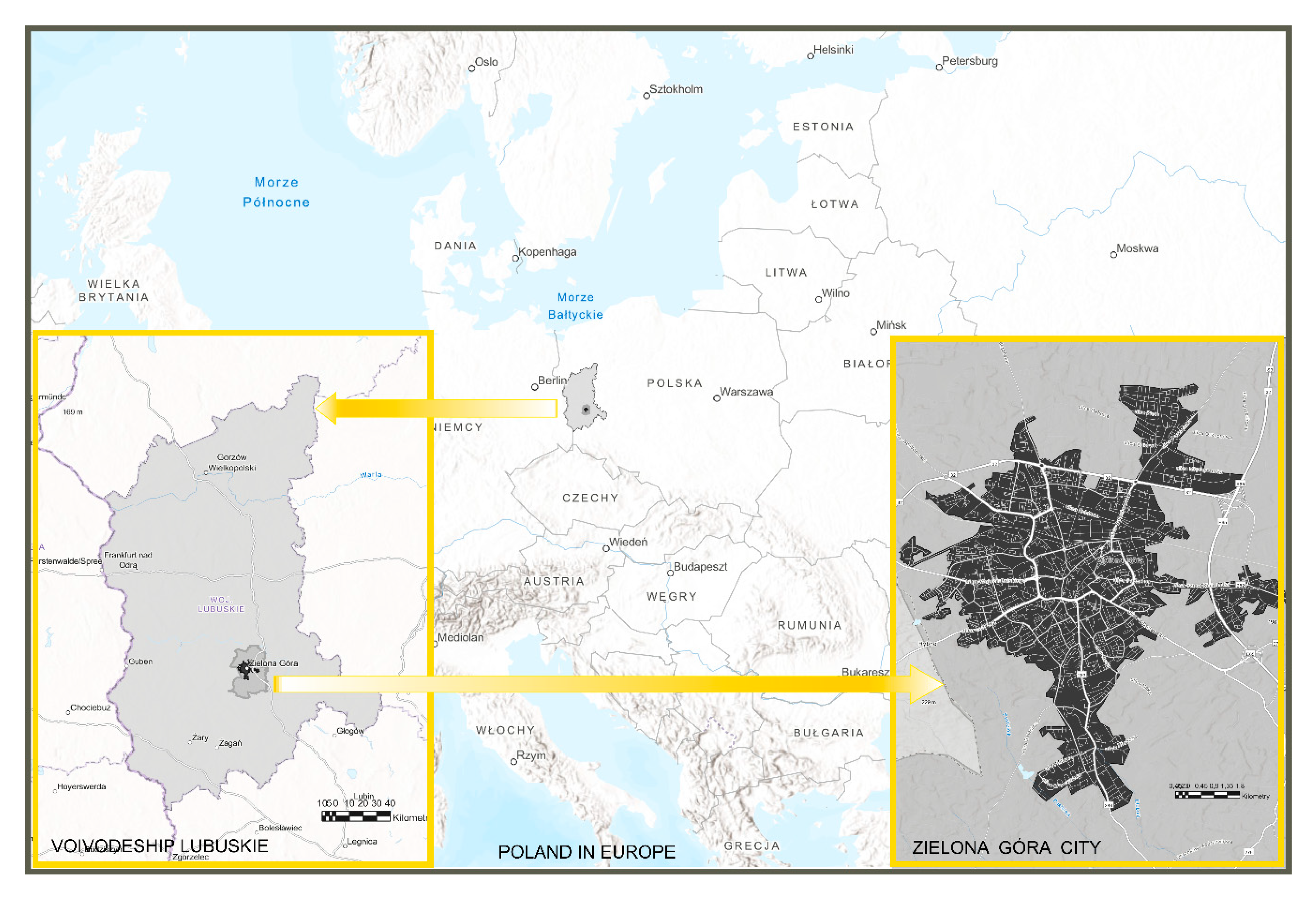

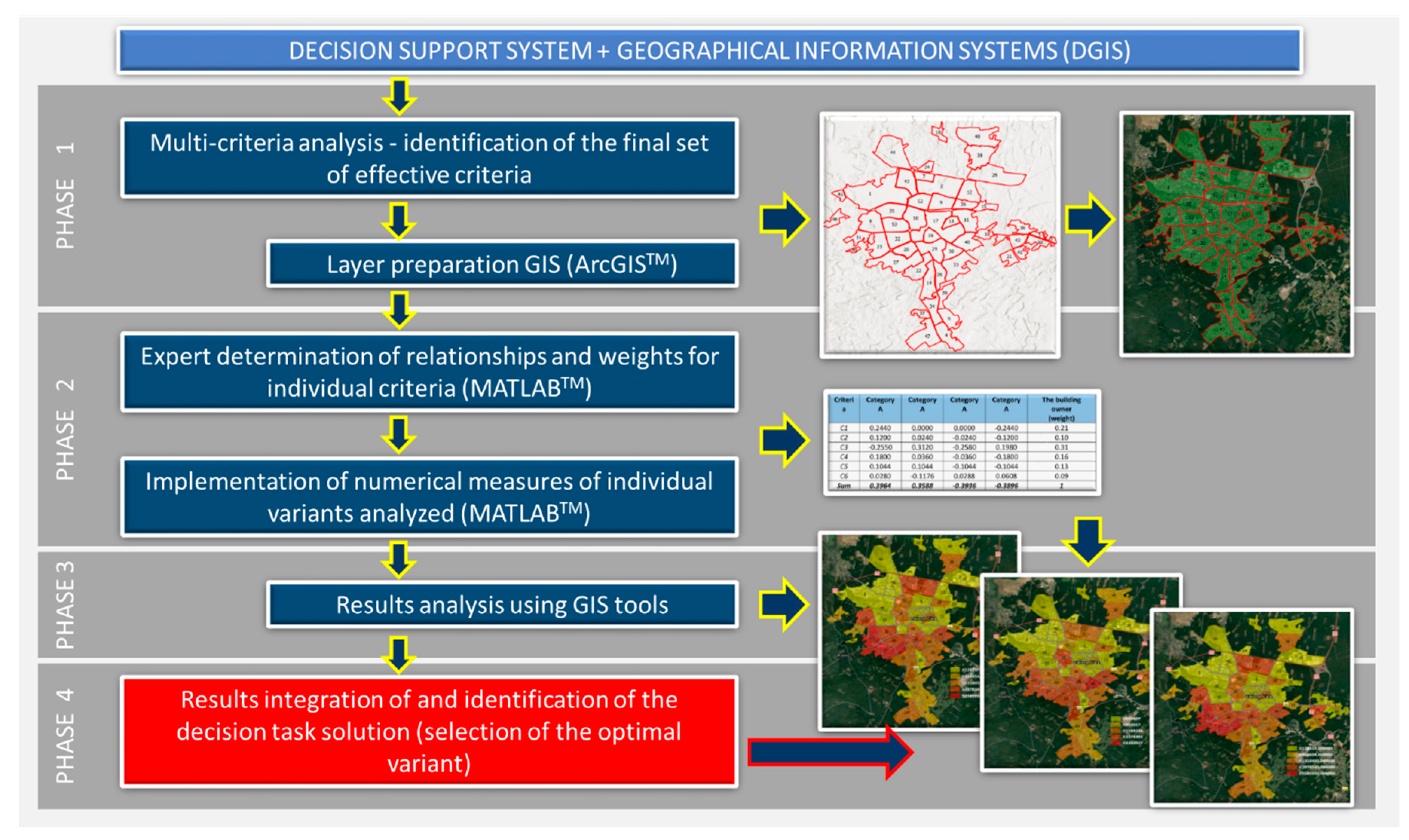
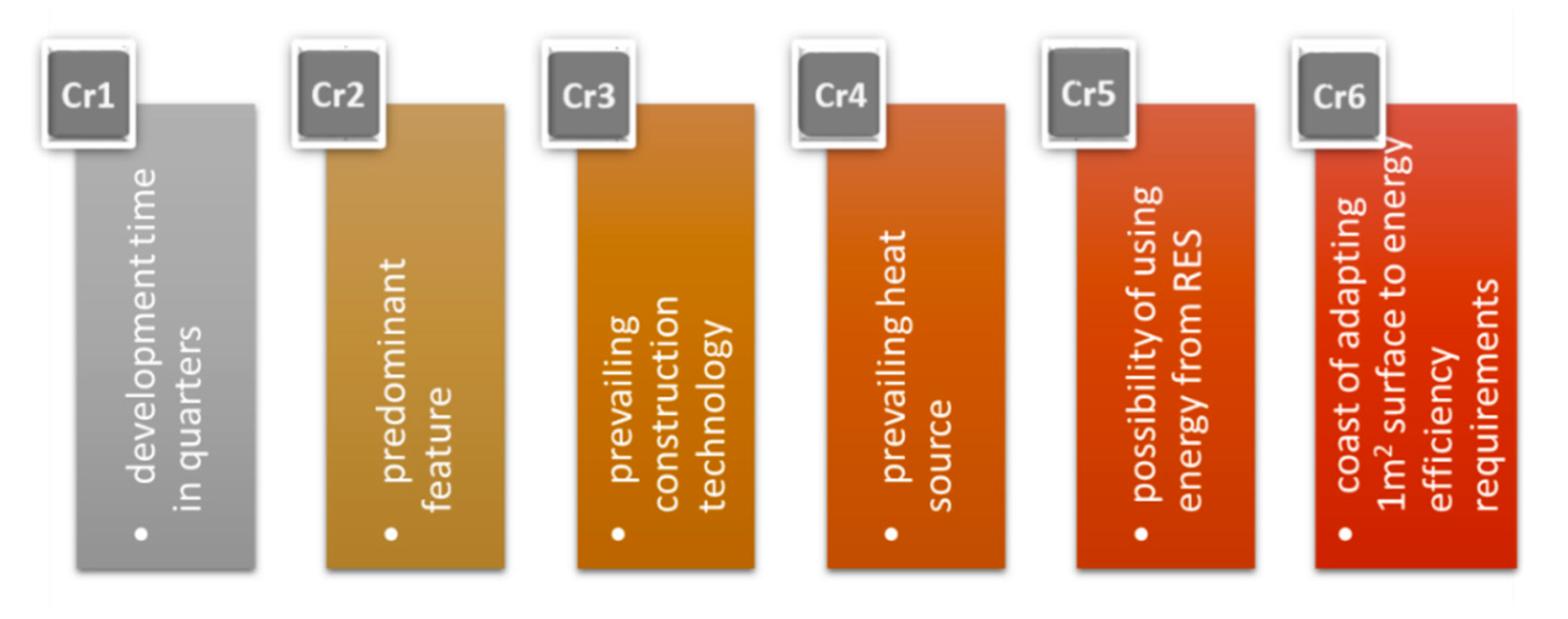
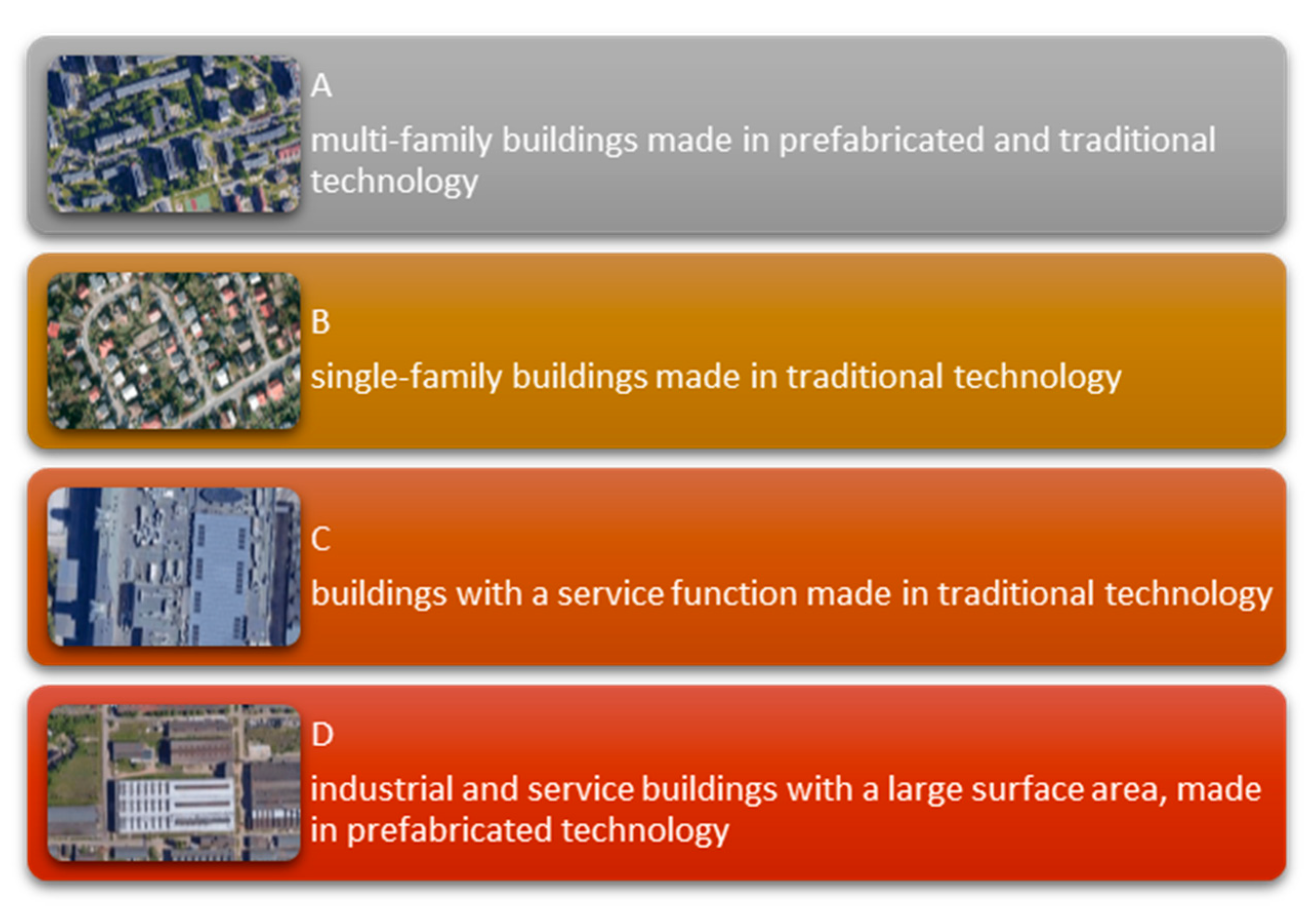
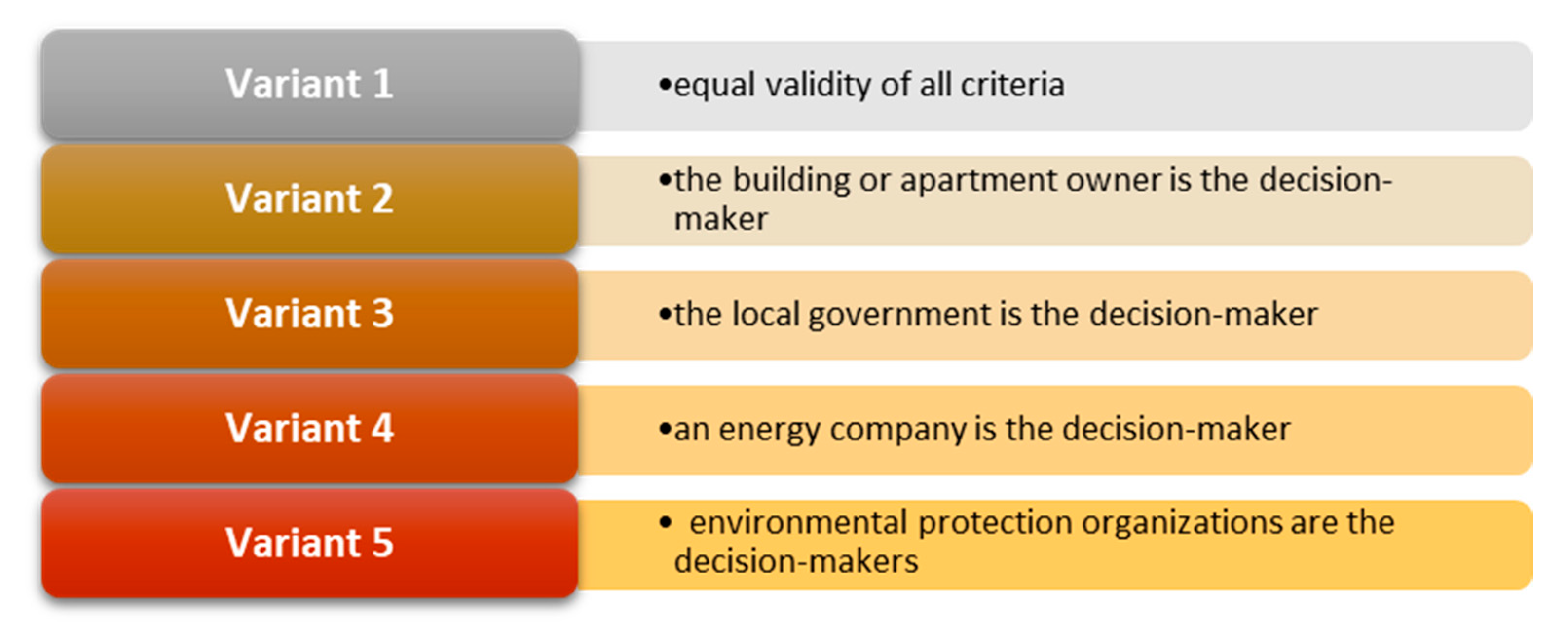
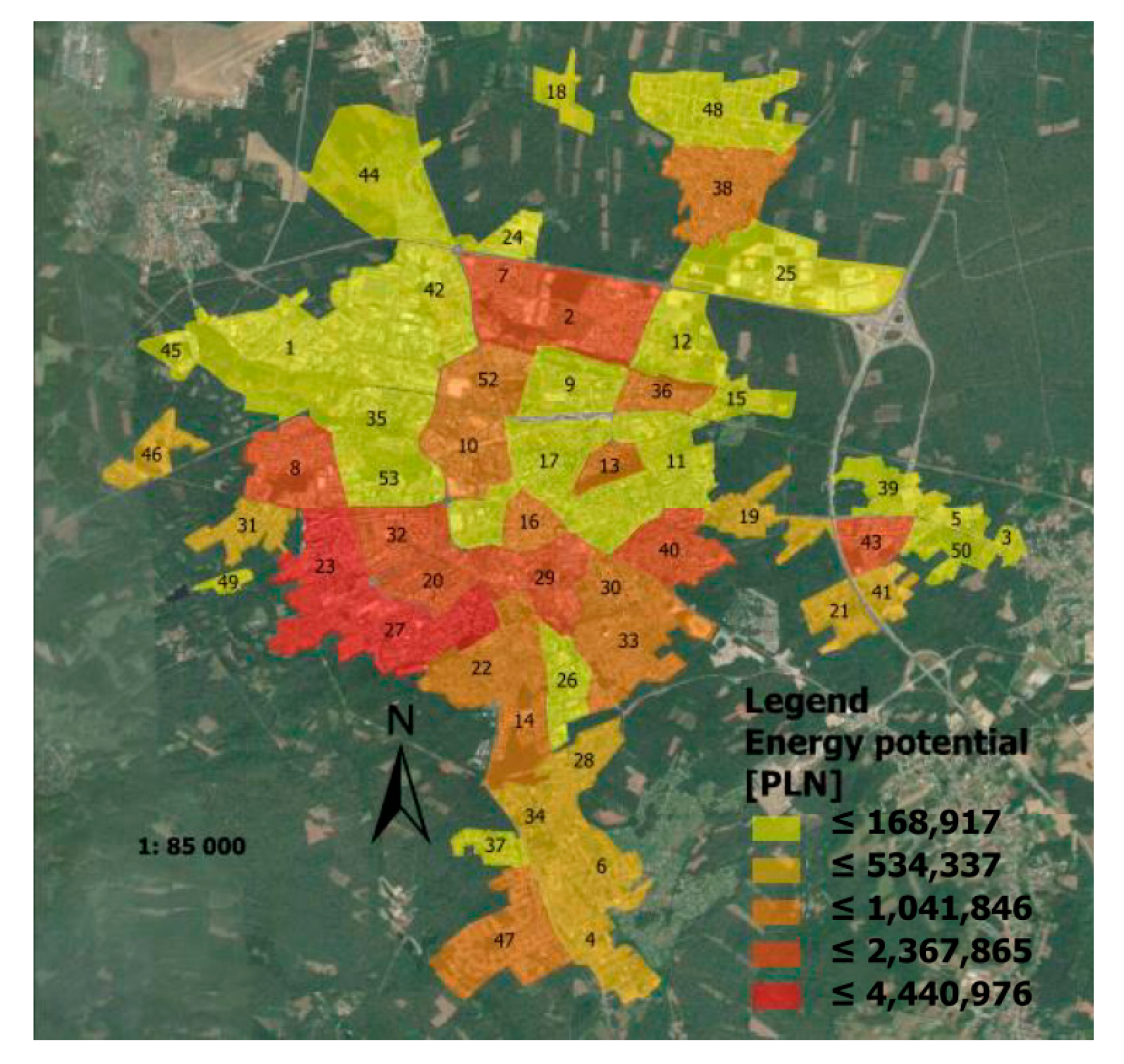
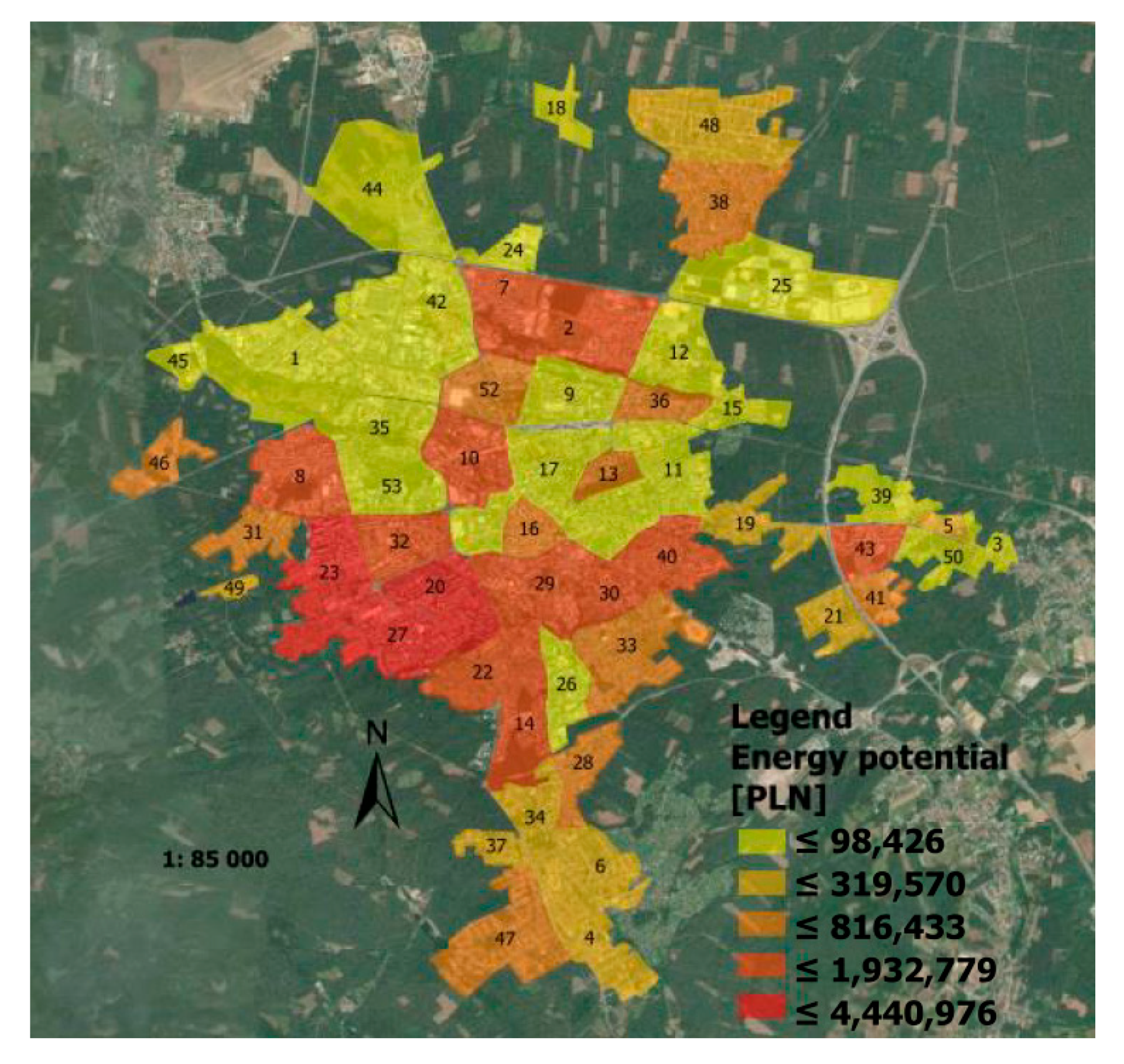
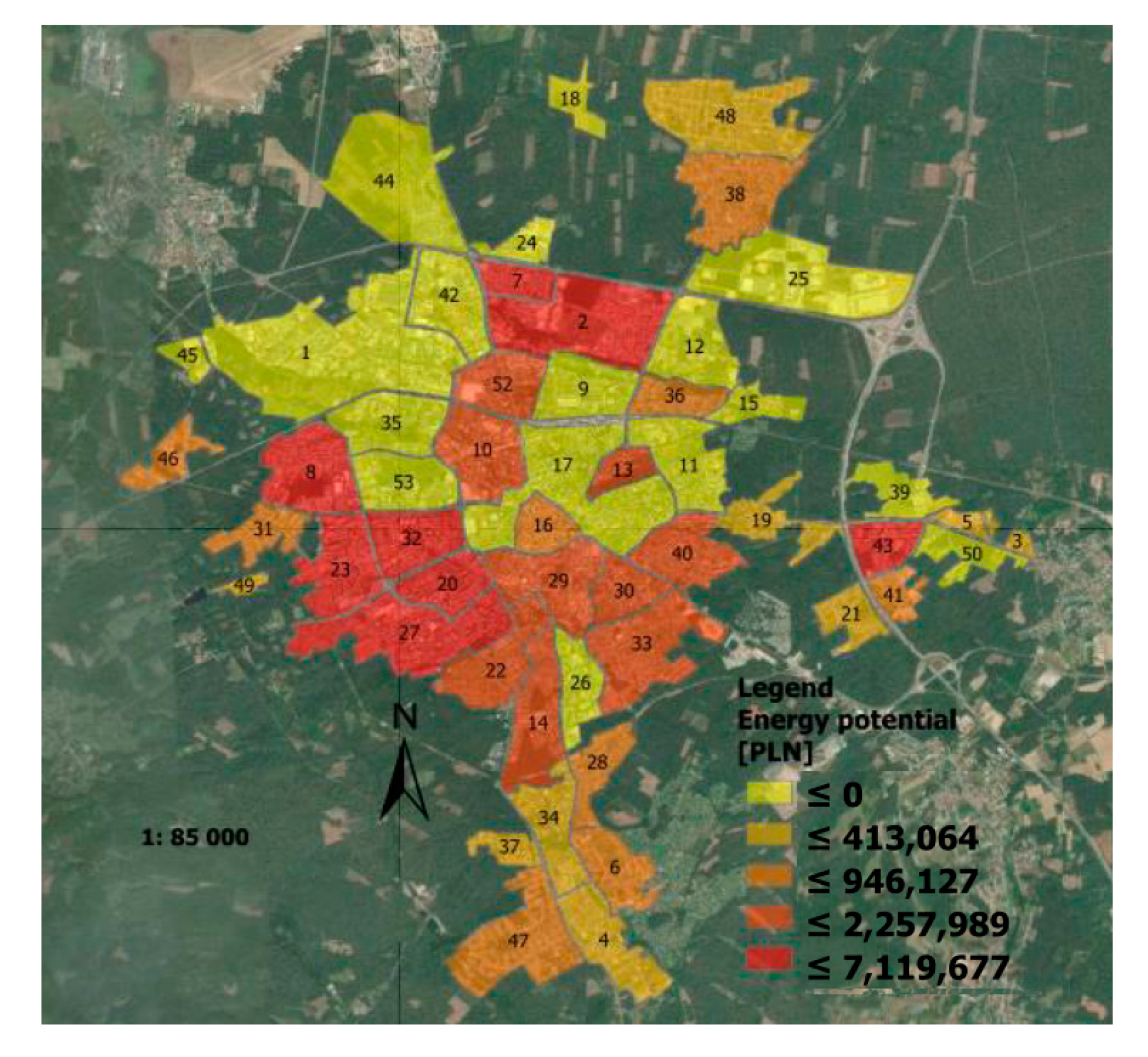
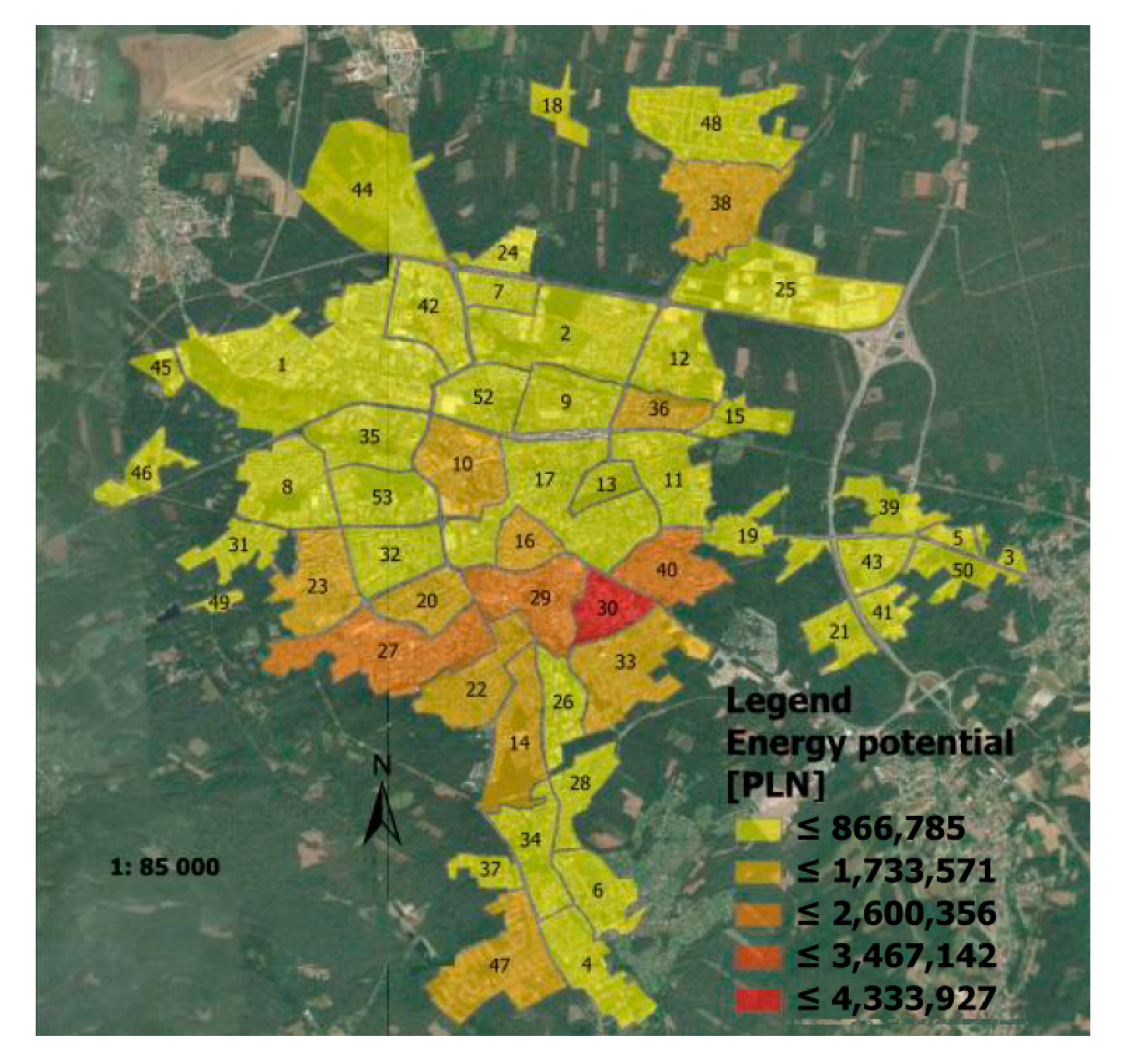
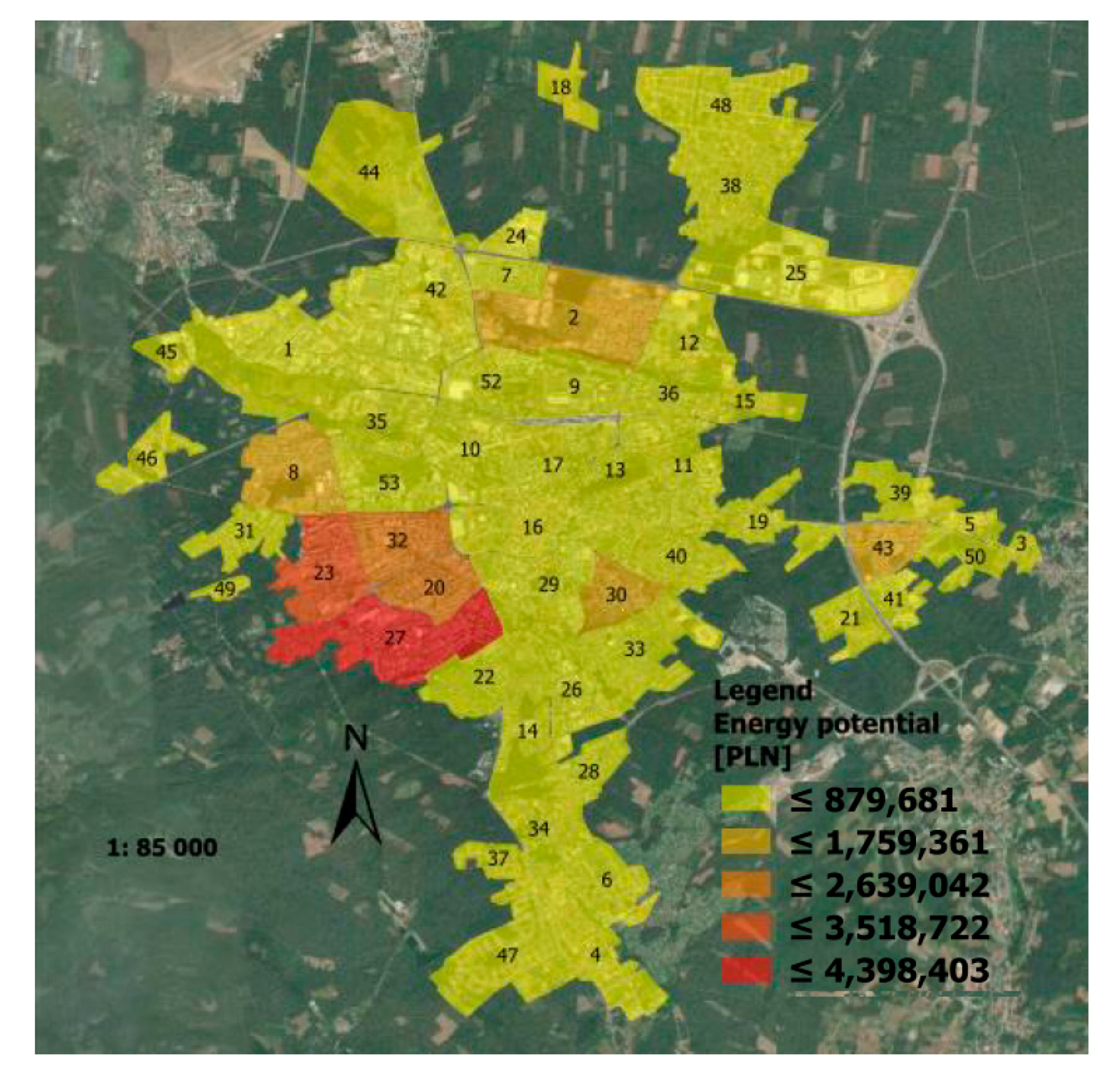
| Input Data | Criteria for Buildings Energy Consumption | Building Groups Categories | Decisions Variants |
| construction years (in quarters) | category A—multi-family buildings made in prefabricated and traditional technology | Option 1—equal validity of all criteria | |
| overwhelming feature | category B—single-family buildings made in traditional technology | Option 2—the decision-maker is the owner of the building or apartment | |
| prevailing state of ownership | category C—buildings with a service function made in traditional technology | Option 3—the local government is the decision-maker | |
| prevailing construction technology | category D—large-area industrial and service buildings constructed in prefabricated technology | Option 4—the energy company is the decision-maker | |
| predominant source of heat | Option 5—decision-makers are representatives of organizations related to environmental protection | ||
| possibility of using energy from RES | |||
| cost of bringing 1 m2 of the facility to EU requirements for energy efficiency |
| Criterion | Buildings Category | |||
|---|---|---|---|---|
| A | B | C | D | |
| creation time | 0.1743 | 0.000 | 0.0000 | −0.1743 |
| function | 0.1714 | 0.0343 | −0.0343 | −0.1714 |
| ownership status | −0.1214 | 0.1486 | −0.1229 | 0.0943 |
| construction technology | 0.1714 | 0.0343 | −0.0343 | −0.1714 |
| heat source | 0.1243 | 0.1243 | −0.1243 | −0.1243 |
| use of energy from RES | 0.0500 | −0.2100 | 0.0514 | 0.1086 |
| coast of adapting 1 m2 surface to UE requirements | −0.0714 | 0.2143 | −0.0714 | -0.0714 |
| Total Adjusted Indicator | 0.4986 | 0.3457 | −0.3357 | −0.5100 |
| Total Adjusted Indicator | Buildings Category | |||
|---|---|---|---|---|
| A | B | C | D | |
| Variant 1 | 0.4986 | 0.3457 | −0.3357 | −0.5100 |
| Variant 2 | 0.3964 | 0.3588 | −0.3936 | −0.3896 |
| Variant 3 | 0.6355 | 0.5015 | −0.3890 | −0.7490 |
| Variant 4 | 0.1651 | 0.5266 | −0.3618 | −0.3304 |
| Variant 5 | 0.3926 | −0.3021 | −0.0875 | −0.0033 |
| The Sum of m2 Usable Floor Area | Energy Potential [PLN]/[€] | ||||
|---|---|---|---|---|---|
| Variant 1 | Variant 2 | Variant 3 | Variant 4 | Variant 5 | |
| 4,233,104 | 31,909,323/ | 26,996,982/ | 42,587,563/ | 21,119,910/ | 9,621,691/ |
| 7,252,119 | 6,135,678 | 9,678,991 | 4,799,979 | 2,186,748 | |
© 2020 by the authors. Licensee MDPI, Basel, Switzerland. This article is an open access article distributed under the terms and conditions of the Creative Commons Attribution (CC BY) license (http://creativecommons.org/licenses/by/4.0/).
Share and Cite
Sztubecka, M.; Skiba, M.; Mrówczyńska, M.; Bazan-Krzywoszańska, A. An Innovative Decision Support System to Improve the Energy Efficiency of Buildings in Urban Areas. Remote Sens. 2020, 12, 259. https://doi.org/10.3390/rs12020259
Sztubecka M, Skiba M, Mrówczyńska M, Bazan-Krzywoszańska A. An Innovative Decision Support System to Improve the Energy Efficiency of Buildings in Urban Areas. Remote Sensing. 2020; 12(2):259. https://doi.org/10.3390/rs12020259
Chicago/Turabian StyleSztubecka, Małgorzata, Marta Skiba, Maria Mrówczyńska, and Anna Bazan-Krzywoszańska. 2020. "An Innovative Decision Support System to Improve the Energy Efficiency of Buildings in Urban Areas" Remote Sensing 12, no. 2: 259. https://doi.org/10.3390/rs12020259
APA StyleSztubecka, M., Skiba, M., Mrówczyńska, M., & Bazan-Krzywoszańska, A. (2020). An Innovative Decision Support System to Improve the Energy Efficiency of Buildings in Urban Areas. Remote Sensing, 12(2), 259. https://doi.org/10.3390/rs12020259





